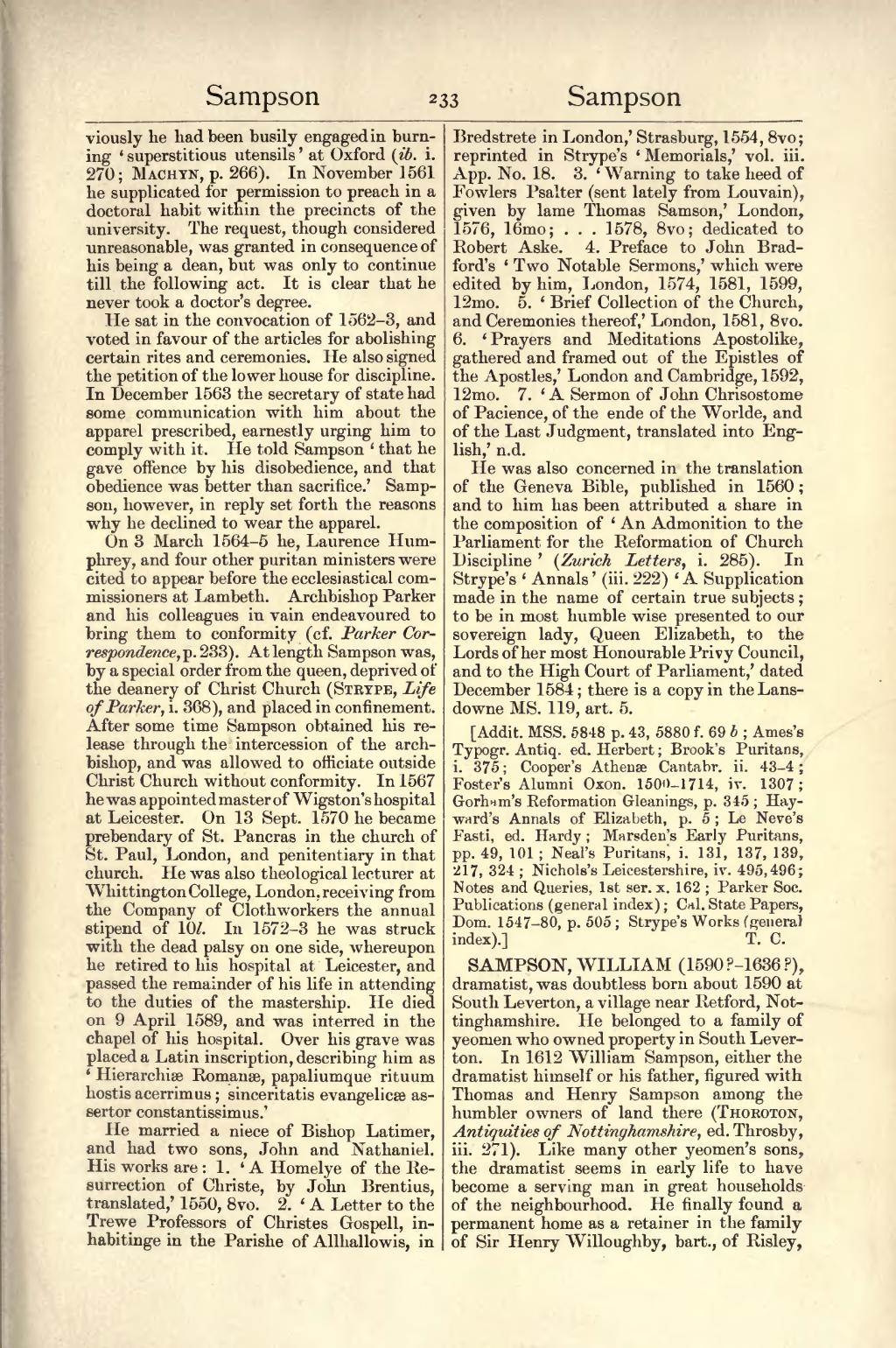viously he had been busily engaged in burning ‘superstitious utensils’ at Oxford (ib. i. 270; Machyn, p. 266). In November 1561 he supplicated for permission to preach in a doctoral habit within the precincts of the university. The request, though considered unreasonable, was granted in consequence of his being a dean, but was only to continue till the following act. It is clear that he never took a doctor's degree.
He sat in the convocation of 1562–3, and voted in favour of the articles for abolishing certain rites and ceremonies. He also signed the petition of the lower house for discipline. In December 1563 the secretary of state had some communication with him about the apparel prescribed, earnestly urging him to comply with it. He told Sampson ‘that he gave offence by his disobedience, and that obedience was better than sacrifice.’ Sampson, however, in reply set forth the reasons why he declined to wear the apparel.
On 3 March 1564–5 he, Laurence Humphrey, and four other puritan ministers were cited to appear before the ecclesiastical commissioners at Lambeth. Archbishop Parker and his colleagues in vain endeavoured to bring them to conformity (cf. Parker Correspondence, p. 233). At length Sampson was, by a special order from the queen, deprived of the deanery of Christ Church (Strype, Life of Parker, i. 368), and placed in confinement. After some time Sampson obtained his release through the intercession of the archbishop, and was allowed to officiate outside Christ Church without conformity. In 1567 he was appointed master of Wigston's hospital at Leicester. On 13 Sept. 1570 he became prebendary of St. Pancras in the church of St. Paul, London, and penitentiary in that church. He was also theological lecturer at Whittington College, London, receiving from the Company of Clothworkers the annual stipend of 10l. In 1572–3 he was struck with the dead palsy on one side, whereupon he retired to his hospital at Leicester, and passed the remainder of his life in attending to the duties of the mastership. He died on 9 April 1589, and was interred in the chapel of his hospital. Over his grave was placed a Latin inscription, describing him as ‘Hierarchiæ Romanæ, papaliumque rituum hostis acerrimus; sinceritatis evangelicæ assertor constantissimus.’
He married a niece of Bishop Latimer, and had two sons, John and Nathaniel. His works are: 1. ‘A Homelye of the Resurrection of Christe, by John Brentius, translated,’ 1550, 8vo. 2. ‘A Letter to the Trewe Professors of Christes Gospell, inhabitinge in the Parishe of Allhallowis, in Bredstrete in London,’ Strasburg, 1554, 8vo; reprinted in Strype's ‘Memorials,’ vol. iii. App. No. 18. 3. ‘Warning to take heed of Fowlers Psalter (sent lately from Louvain), given by lame Thomas Samson,’ London, 1576, 16mo; … 1578, 8vo; dedicated to Robert Aske. 4. Preface to John Bradford's ‘Two Notable Sermons,’ which were edited by him, London, 1574, 1581, 1599, 12mo. 5. ‘Brief Collection of the Church, and Ceremonies thereof,’ London, 1581, 8vo. 6. ‘Prayers and Meditations Apostolike, gathered and framed out of the Epistles of the Apostles,’ London and Cambridge, 1592, 12mo. 7. ‘A Sermon of John Chrisostome of Pacience, of the ende of the Worlde, and of the Last Judgment, translated into English,’ n.d.
He was also concerned in the translation of the Geneva Bible, published in 1560; and to him has been attributed a share in the composition of ‘An Admonition to the Parliament for the Reformation of Church Discipline’ (Zurich Letters, i. 285). In Strype's ‘Annals’ (iii. 222) ‘A Supplication made in the name of certain true subjects; to be in most humble wise presented to our sovereign lady, Queen Elizabeth, to the Lords of her most Honourable Privy Council, and to the High Court of Parliament,’ dated December 1584; there is a copy in the Lansdowne MS. 119, art. 5.
[Addit. MSS. 5848 p. 43, 5880 f. 69 b; Ames's Typogr. Antiq. ed. Herbert; Brook's Puritans, i. 375; Cooper's Athenæ Cantabr. ii. 43–4; Foster's Alumni Oxon. 1500–1714, iv. 1307; Gorham's Reformation Gleanings, p. 345; Hayward's Annals of Elizabeth, p. 5; Le Neve's Fasti, ed. Hardy; Marsden's Early Puritans, pp. 49, 101; Neal's Puritans, i. 131, 137, 139, 217, 324; Nichols's Leicestershire, iv. 495, 496; Notes and Queries, 1st ser. x. 162; Parker Soc. Publications (general index); Cal. State Papers, Dom. 1547–80, p. 505; Strype's Works (general index).]
SAMPSON, WILLIAM (1590?–1636?), dramatist, was doubtless born about 1590 at South Leverton, a village near Retford, Nottinghamshire. He belonged to a family of yeomen who owned property in South Leverton. In 1612 William Sampson, either the dramatist himself or his father, figured with Thomas and Henry Sampson among the humbler owners of land there (Thoroton, Antiquities of Nottinghamshire, ed. Throsby, iii. 271). Like many other yeomen's sons, the dramatist seems in early life to have become a serving man in great households of the neighbourhood. He finally found a permanent home as a retainer in the family of Sir Henry Willoughby, bart., of Risley,
